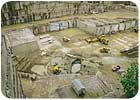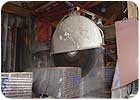
Located on the open plains of Milbank, SD, Dakota Granite Co. operates a full-scale stone-processing plant and several quarries. The company was incorporated in June of 1925 as a wholesale quarrier/fabricator of Dakota Mahogany monuments. Initially, it had seven employees who worked at a shop and quarry that was six miles east of Milbank. Today, Dakota Granite has grown to include approximately 85 employees, and in addition to manufacturing monuments, the company has established itself as a block supplier.
“There were some Scotsmen who came through the area and found granite outcroppings,” said Rick Dilts, Vice President of Sales and Marketing, adding that they did some testing on the stone. “They weren’t good businessmen though, so they partnered with a banker who later bought the two of them out.”
Until 1965, the growth of Dakota Granite Co. was attributed to the production and sales of monuments to over 2,500 retail granite shops throughout the U.S., according to the company. “We started out fabricating monuments and quarrying, and then in the ‘60s, we were contacted by a Japanese customer who wanted blocks,” explained Dilts. Currently, about 40% of the blocks quarried by Dakota Granite are shipped to companies around the world, including Italy, Japan, China and Malaysia.
“We made the decision long ago to be a block supplier to the countertop and cut-to-size industry,” said Dilts. “If we sold slabs to countertop fabricators, we would be in direct competition with the companies that buy their blocks from us. The last thing the block buyer wants is for us to sell blocks to him, then turn around and sell slabs to his customer. We mainly sell blocks to block yards and slab fabricators.”

The quarries
Today, Dakota Granite Co. owns and operates five quarries - four in South Dakota and one in Bellingham, MN. Located adjacent to its office and processing plant, the Sunset Mahogany quarry is the company’s largest site. Originally started in the 1960s and expanded in the 1980s, the quarry sits on 460,000 square feet and runs about 200 feet deep. While some of the granite is used for block sales, Sunset Mahogany is primarily used for monuments and mausoleums.“The Sunset [quarry] is as deep as 8 miles,” said Dilts. “The problem with going deeper is the pressure down there. You see stones popping out like popcorn.”
Dilts went on to say that Dakota Granite Co. had used derricks in conjunction with drilling and blasting to quarry granite, but now it has converted to wire saws. “It gives us a lot more flexibility with our block sizes,” he said, explaining that the average block size is 9 feet x 6 feet x 4 feet, 6 inches. Switching to wire saws also allows Dakota Granite Co. to increase its yield - therefore leaving less waste.
At the time of Stone World’s visit, workers were cutting loafs at the Sunset Mahogany site that measured 24 feet tall. The quarries run 6 a.m. to 4:30 p.m., seven days a week, and the Sunset Mahogany site produces 1 million cubic feet annually.
In addition to the quarry for Sunset Mahogany, two sites produce Dakota Mahogany granite, which is a variegated material with orange and black variegation in most blocks. Because of the granite’s rich warm color and durability, it is often chosen for exterior and interior design applications in both commercial and residential design.
The Whetstone and Brown Velvet quarries are used for both construction and monumental projects, according to the company. These selections are Dakota Mahogany with subtle differences in background color and grain structure. While some “Monumental Grade” Dakota Mahogany is available in the Whetstone and Brown Velvet varieties, generally, uniform large panel sizes of Dakota Mahogany are rare, reports Dakota Granite Co. “Construction Grade” material will have movement and variegation, and it is used for mostly projects, including countertop slabs.
The Whetstone site is the larger of the two - spanning 360,000 square feet and producing 1.1 million cubic feet annually. The Brown Velvet quarry covers 160,000 square feet and produces 311,000 cubic feet a year.
Another exclusive material quarried by Dakota Granite Co. is American Bouquet granite. This is a coarse-grained variegated red/orange material that is used for monuments and occasionally for building projects. “We consider it to be a different material [than Dakota Mahogany],” explained Dilts, adding that the site measures 60,000 square feet, and it has an annual production capacity of 80,000 cubic feet. “The American Bouquet quarry is one mile south of our Mahogany quarries, and it has more of a salmon color to it.”
Additionally, the company’s quarry in Minnesota produces Bellingham granite - a finer grained pink/beige material with some black in the background and occasionally a black streak. While Bellingham granite is primarily used for monuments, some large blocks are available. “Bellingham is only quarried when we need it,” said Dilts.
According to Chuck Monson, company president, Dakota Granite Co. is very diligent in the environmental reclamation process at all of its sites. Although the company’s facility sits on the prairies of South Dakota, a “mountain range” is visible in the distance. “It is manmade of waste,” said Monson. “The state comes once a year and gives us suggestions. We spend a great deal of time making it look natural.”

Dakota Granite Co.'s stone-processing facility
In addition to operating its five quarries, Dakota Granite Co. also runs a full-scale fabricating plant for producing monuments and mausoleums. The approximate 105,000-square-foot facility is equipped with state-of-the-art equipment, which plays a critical role in the production process.In 2005, the company invested in computerized wire saws. These saws allow Dakota Granite Co. to cut any shape imaginable, according to the company. Additionally, a large block cutter and a Pellegrini wire saw are used to trim granite blocks.
“The large wire saw allows us to cut 18- x 12-foot slabs for mausoleums,” said Rick Dilts, Vice President of Sales and Marketing. Among other machinery in the plant is a Hensel bed polisher as well as a Prodigy bridge saw and a Hydrasplit, both from Park Industries of St. Cloud, MN.
While the primary focus of the company’s stone-processing facility is to produce monuments and mausoleums, the company does do a small amount of countertop and cut-to-size production for the local market. As a result, the facility includes a Pro-Edge II bridge saw from Park Industries for this purpose.
“We only fabricate countertops on a local level, and even that’s a very small number,” said Dilts. He explained that approximately 20% of the company’s business is raw material, which is sold to both a national and international market. A total of 15 to 20% is comprised of cut-to-size work, which is used for larger projects, and the rest of Dakota Granite Co.’s business is monuments and mausoleums. “Between monuments, mausoleums, countertops and anything else that involves processing, we fabricate approximately 2,800 pieces per month,” said Dilts.
